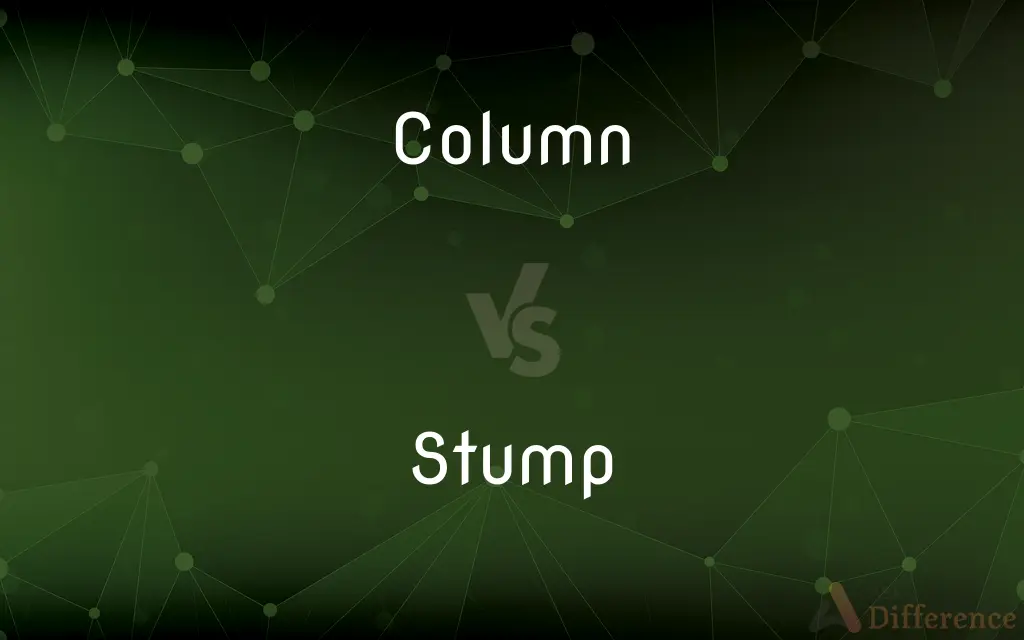Column vs. Stump — What's the Difference?
Edited by Tayyaba Rehman — By Maham Liaqat — Updated on February 24, 2024
A column is a vertical structural element that supports weight, often decorative, while a stump is the remainder of a tree trunk after the tree has been cut down.

Difference Between Column and Stump
Table of Contents
ADVERTISEMENT
Key Differences
Columns are architectural features or structural supports that can be both functional and decorative. They have been used throughout history in various styles of architecture to support buildings and other structures. Stumps are what remains of trees after they have been felled. They consist of the lower part of the trunk and the roots that remain in the ground.
Columns can be made from materials like stone, concrete, or metal, and are designed according to specific orders or styles, such as Doric, Ionic, and Corinthian, which dictate their proportions and decorations. Stumps are often left in the landscape after tree removal due to the difficulty of removal. They can provide ecological benefits, such as habitat for wildlife, but may also be considered unsightly or a nuisance in managed landscapes.
The purpose and creation of columns and stumps are fundamentally different. Columns are intentionally created and placed as part of construction projects to support and enhance buildings. They are planned, designed, and crafted with specific materials to fulfill both structural and aesthetic roles within architecture. Stumps result from the cutting or removal of trees and are not created for a specific purpose in their own right. The process of becoming a stump is incidental to tree removal, whether for lumber, land clearing, or safety reasons. Unlike columns, stumps are not designed or constructed but are the natural consequence of tree removal.
Columns often symbolize strength, stability, and sometimes the aesthetic ideals of a culture or period. They can be integral to the design of buildings and structures, influencing their appearance and functionality. The design and placement of columns take into consideration load-bearing capabilities, architectural style, and the material's characteristics. Stumps can have ecological value or serve as historical reminders of the landscape's past use or management. They can be repurposed into furniture, decorative items, or left to decompose naturally, enriching the soil and providing habitats. However, their presence is often more related to the natural lifecycle or land use changes rather than deliberate design or construction.
Comparison Chart
Definition
A structural or decorative vertical element
The remainder of a tree trunk
ADVERTISEMENT
Purpose
Supports weight, enhances aesthetics
Result of tree removal
Material
Stone, concrete, metal, etc.
Wood
Creation
Designed and constructed
Natural consequence of cutting a tree
Function
Structural support, architectural feature
Ecological benefit, nuisance
Symbolism
Strength, stability, architectural beauty
Natural cycle, history of land use
Design
Follows architectural orders and styles
Shape determined by the tree and cut
Compare with Definitions
Column
One of two or more vertical sections of text lying side by side in a document and separated by a rule or a blank space.
Stump
A potential habitat for wildlife.
The stump has become home to various insects and fungi.
Column
A vertical structure usually consisting of a base, a cylindrical shaft, and a capital, used as a support or standing alone as a monument.
Stump
The part of a tree or plant remaining in the earth after the stem or trunk is cut off; the stub.
Column
Any slender vertical support, as of steel or reinforced concrete.
Stump
The remains of a tree trunk after it has been cut.
The old oak's stump was left in the field.
Column
A vertical line of entries in a table, usually read from top to bottom.
Stump
The base part of a tree that remains standing after the tree has been felled
Column
A vertical structural element that supports weight.
The ancient temple's columns have stood for centuries.
Stump
A natural consequence of tree removal.
Stumps dot the landscape after the clearing.
Column
A support pillar made from materials like stone or concrete.
The building's lobby features marble columns.
Stump
An ecological component of a forest.
Stumps play a role in the forest's ecosystem.
Column
An arrangement of numbers in a single vertical line.
Stump
The part of a tree trunk left protruding from the ground after the tree has fallen or has been felled.
Column
A vertical glass tube used in column chromatography; a mixture is poured in the top and washed through a stationary substance where components of the mixture are adsorbed selectively to form colored bands
Stump
Remove tree stumps from;
Stump a field
Column
Part of a building's structure.
Columns are integral to the building's design.
Stump
A reminder of the natural or land use history.
Each stump in the park tells a story of the area's past.
Column
A symbol of strength and stability.
The column represents the company's solid foundation.
Column
A vertical structure standing alone and not supporting anything (as a monument or a column of air)
Column
(architeture) a tall cylindrical vertical upright and used to support a structure
Column
An architectural feature, often decorative.
The front porch is adorned with white columns.
Column
Something having similar vertical form or structure to the things mentioned above, such as a spinal column.
Common Curiosities
What is the primary function of a column?
To provide structural support and enhance architectural aesthetics.
Do stumps have any benefits?
Yes, they can provide habitats for wildlife and contribute to soil enrichment as they decompose.
Why are stumps left after trees are cut down?
Due to the difficulty of removal and potential ecological benefits.
Can columns be purely decorative?
Yes, columns can be designed as non-load-bearing, serving only decorative purposes.
Can stumps be removed easily?
Stump removal can be challenging and often requires specialized equipment or techniques.
Can stumps be considered a nuisance?
Yes, in managed landscapes, stumps can be seen as unsightly or obstacles.
What happens to stumps over time?
They may decompose, be removed, or be repurposed for decorative or functional uses.
How are columns designed?
Columns are designed according to architectural orders and styles, considering material, proportions, and intended load-bearing capacity.
Are all columns made from stone or concrete?
No, columns can also be made from wood, metal, and other materials, depending on the architectural requirements.
Do columns have a standard design?
While there are classical orders with standard designs, modern columns may vary widely in style and appearance.
How do columns contribute to a building's aesthetics?
Columns can define architectural style, enhance visual appeal, and contribute to a building's overall beauty and proportion.
Can stumps serve any practical purpose after tree removal?
Stumps can be used as natural seating, play features, or be carved into decorative items.
How do the materials of columns affect their function and design?
The choice of material impacts a column's load-bearing capacity, durability, and suitability for different architectural styles and climates.
Are there any cultural or symbolic meanings associated with columns?
Yes, columns often symbolize strength, stability, and in some cultures, represent historical or religious significance.
What is the ecological impact of leaving stumps in place?
Leaving stumps can enhance biodiversity by providing habitats and contributing to the nutrient cycle.
Share Your Discovery

Previous Comparison
Appendix vs. Index
Next Comparison
Gates vs. GateAuthor Spotlight
Written by
Maham LiaqatEdited by
Tayyaba RehmanTayyaba Rehman is a distinguished writer, currently serving as a primary contributor to askdifference.com. As a researcher in semantics and etymology, Tayyaba's passion for the complexity of languages and their distinctions has found a perfect home on the platform. Tayyaba delves into the intricacies of language, distinguishing between commonly confused words and phrases, thereby providing clarity for readers worldwide.
















































